If you’re looking for an exciting, flashy aquarium pet with a vibrant personality, the Midas Cichlid or Red Devil Cichlid could be just the fish for you! These two species may be aggressive and pushy with other fish, but they bear a surprising affection for their owners and even enjoy being petted! Compare the Midas Cichlid vs Red Devil Cichlid to find out which one is best for you.
Comparing a Midas Cichlid vs a Red Devil Cichlid
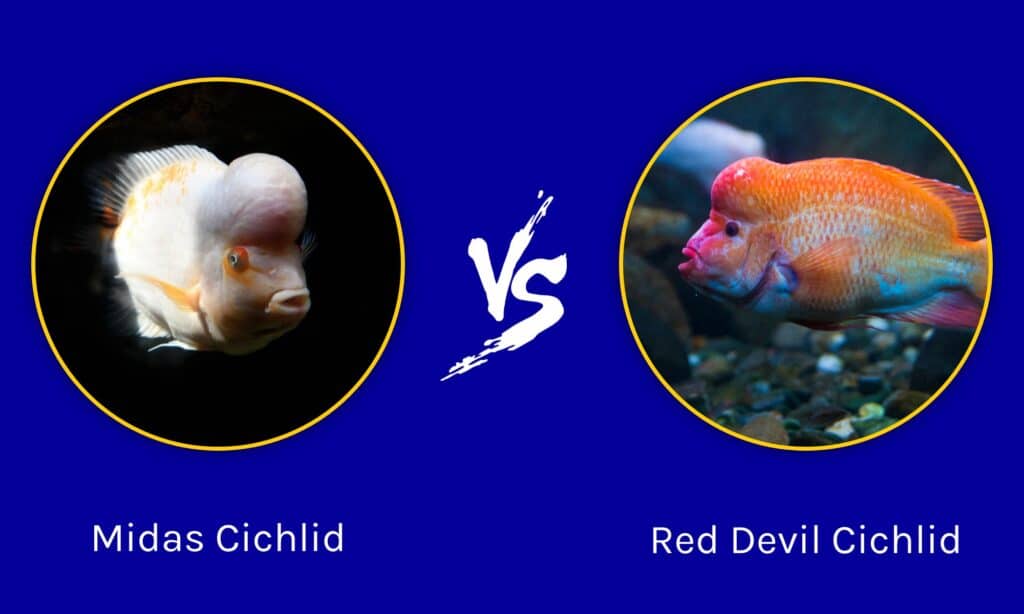
| Midas Cichlid | Red Devil Cichlid | |
|---|---|---|
| Scientific Name | Amphilophus citrinellus | Amphilophus labiatus |
| Natural Habitat | Central America | Central America |
| Size | Length: 10-14 inches (males will be larger than females) Weight: Up to 2.5 pounds | Length: 15 inches (males will be larger than females) Weight: Up to 2.6 pounds |
| Appearance | Colour: Black, grey, white, yellow, orange, red, occasional bar patterns Appearance: Thick, sturdy body; pointed dorsal and anal fins; nuchal hump (more pronounced in males than females) | Colour: Grey, white, green, pink, red, occasional spots or bands on the tail Appearance: Thick, sturdy body; pointed dorsal and anal fins; nuchal hump (more pronounced in males than females) |
| Reproduction | Ovuliparous (the male fertilizes the eggs after the female lays them) | Ovuliparous (the male fertilizes the eggs after the female lays them) |
| Temperament | Territorial, aggressive, affectionate toward owners | Territorial, extremely aggressive, affectionate toward owners |
The 7 Main Differences Between a Midas Cichlid and a Red Devil Cichlid
Though these two fish may appear similar, they have certain differences. Read on to find out how they compare in terms of natural habitat, size, appearance, reproduction, and temperament.
Midas Cichlid vs Red Devil Cichlid: Natural Habitat
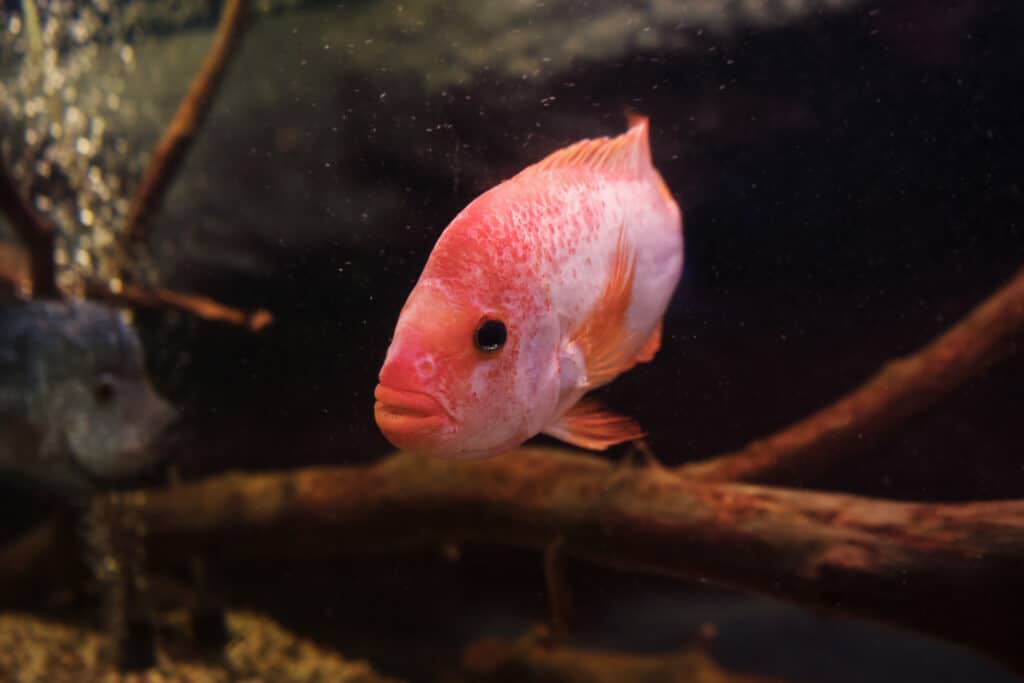
The Red Devil Cichlid is common in Lake Nicaragua, Lake Managua, and Lake Xiloa.
©Anney_Lier/Shutterstock.com
Both the Midas and the Red Devil Cichlids are native to Central America, and they can be found in the countries Nicaragua and Costa Rica. As freshwater fish, they inhabit ponds, lakes, and slow-moving rivers. They prefer shallow, calm waters with depths between 3–114 feet. The Midas Cichlid is especially common in Lake Apoyo, Lake Masaya, and Lake Nicaragua. The Red Devil Cichlid is common in Lake Nicaragua, Lake Managua, and Lake Xiloa.
Being omnivorous species that rely mostly on fish and insects for their sustenance, both types of cichlids prefer to hang out around rocks and tree roots. Here they find food in the form of small fish, snails, insect larvae, aufwuchs, worms, and other creatures. They tend to be duller in color than aquarium fish, which helps them camouflage in the wild. Despite their predatory nature, they themselves may face predation from humans, larger fish, and birds of prey.
Midas Cichlid vs Red Devil Cichlid: Size
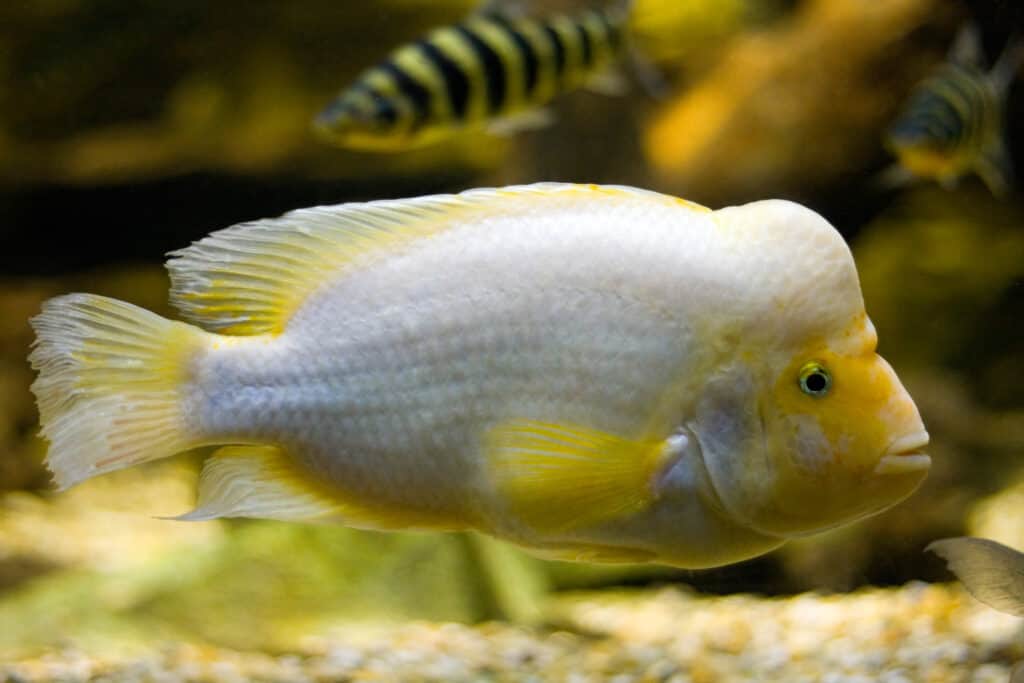
The Midas Cichlid can weigh up to 2.5 pounds.
©kostudio/Shutterstock.com
The Midas Cichlid is the smaller of the two fish, growing 10-14 inches in length. Males tend to be noticeably larger than females, sometimes growing to over a foot long. They can weigh up to 2.5 pounds, making them one of the larger aquarium fish.
The Red Devil Cichlid is slightly larger than its Midas cousin. It can grow up to 15 inches in length, with males typically being significantly larger than females. This species can weigh up to 2.6 pounds. Any aquarium for either of these cichlids must be spacious enough to accommodate them. Experts recommend a tank with at least 55 gallons capacity for a single fish and at least 125 gallons for two. For more than two of these fish, a tank capacity of at least 200 gallons is required.
Midas Cichlid vs Red Devil Cichlid: Appearance
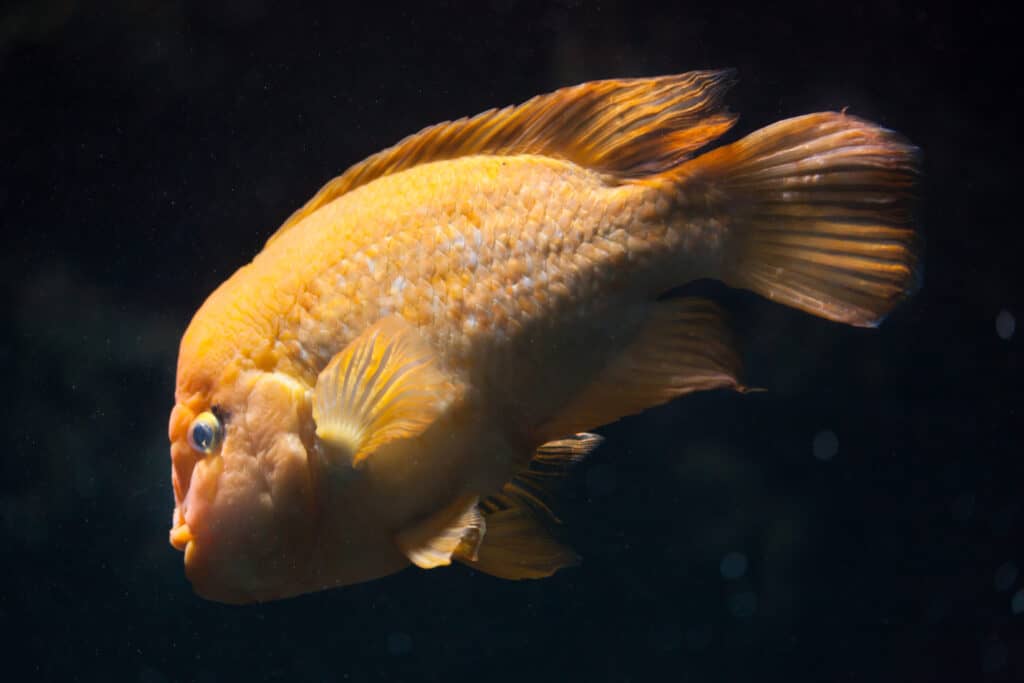
Midas Cichlids have thick bodies and pointed dorsal and anal fins.
©Vladimir Wrangel/Shutterstock.com
The Midas Cichlid usually begins life with a dull grey color, but as it grows, that color may change to anything from black to white to yellow to orange to red. Bar patterns are not uncommon among these fish, though they usually disappear in captivity for unknown reasons. Midas Cichlids have thick bodies and pointed dorsal and anal fins. Nuchal humps (round forehead protuberances) appear in both males and females as they mature, but they are much more pronounced in males.
The Red Devil Cichlid comes in a variety of colors. These colors include grey, white, green, pink, and red. Spots or bands on the tail are common. This fish appears similar in most ways to the Midas Cichlid, though it is usually slightly larger. Nuchal humps also occur in this species.
Midas Cichlid vs Red Devil Cichlid: Reproduction
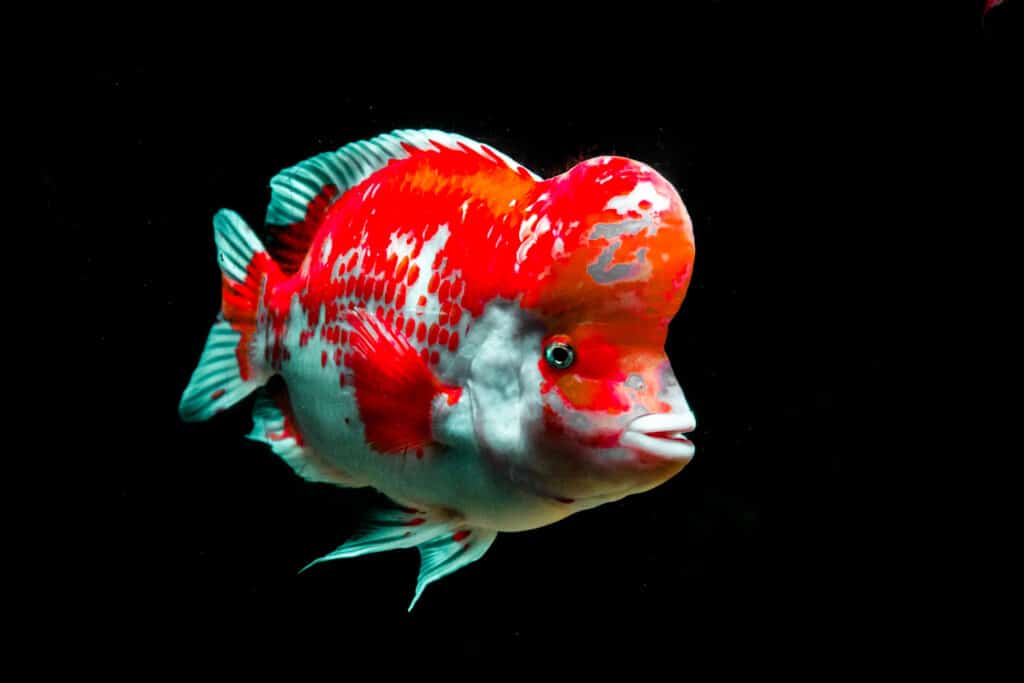
Midas Cichlids and Red Devil Cichlids are monogamous, taking only one mate.
©Andrej Jakubik/Shutterstock.com
Both Midas Cichlids and Red Devil Cichlids are ovuliparous, which means the male fertilizes the eggs after the female lays them. Because they lay eggs instead of giving birth to live young, these fish are never technically pregnant. Both species are monogamous, taking only one mate, and they reach sexual maturity at 6-7 inches.
One female can spawn between 600-700 eggs at one time, although that number may climb as high as 1000. The male then fertilizes the eggs, and both parents eat any that remain unfertilized. After 2-5 days, the eggs hatch. Both parents guard the eggs and fry and can be extremely territorial. The fry are usually ready to eat regular food around the end of their first week of life.
Midas Cichlid vs Red Devil Cichlid: Temperament
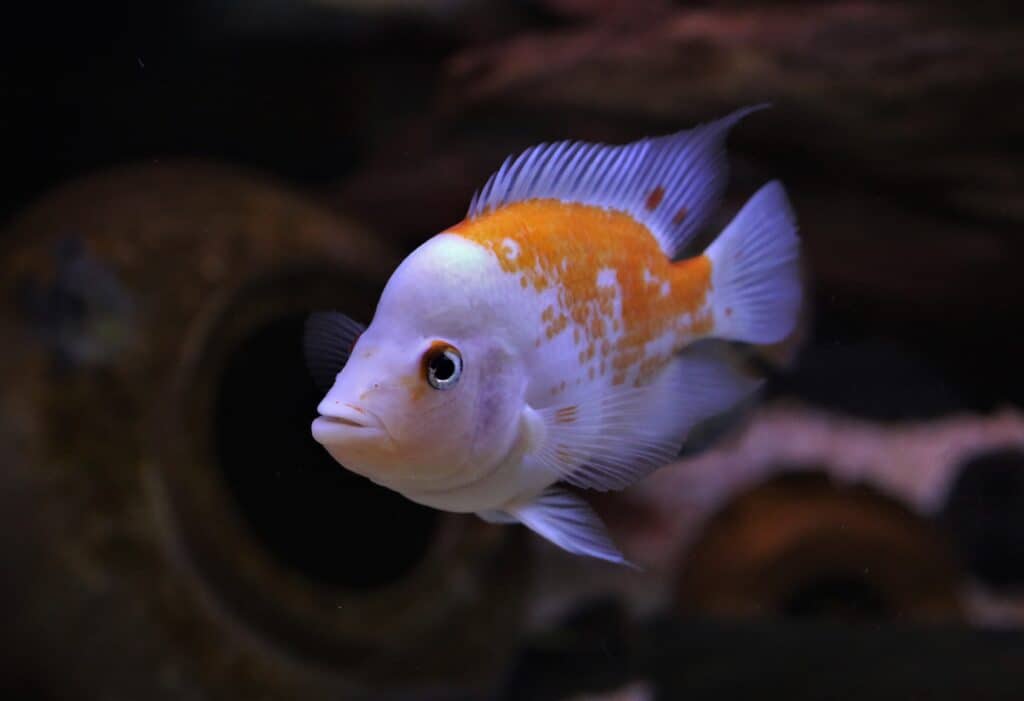
Much like this Siamese Fighting Fish, Red Devil Cichlids are especially aggressive and territorial.
©Arunee Rodloy/Shutterstock.com
Midas Cichlids are naturally territorial and aggressive toward other fish. Pet owners may find them fighting over space or food with the other aquarium inhabitants or battling it out at mating time. Since these fish are omnivorous, they may even eat other fish in the tank. However, despite this predatory temperament, Midas Cichlids can be very affectionate toward their owners. They may allow petting, vie for attention, or even recognize human faces.
Red Devil Cichlids are also omnivores, though fish comprise most of their diet. For this reason, they may also snack on their tank companions. They are arguably even more aggressive than Midas Cichlids, often taking exception even to members of their species. A solitary existence suits them best and will keep other piscine pets from meeting an untimely end. Like Midas Cichlids, Red Devils easily become attached to their owners and love interacting with them.
Midas Cichlid vs Red Devil Cichlid: Life Expectancy
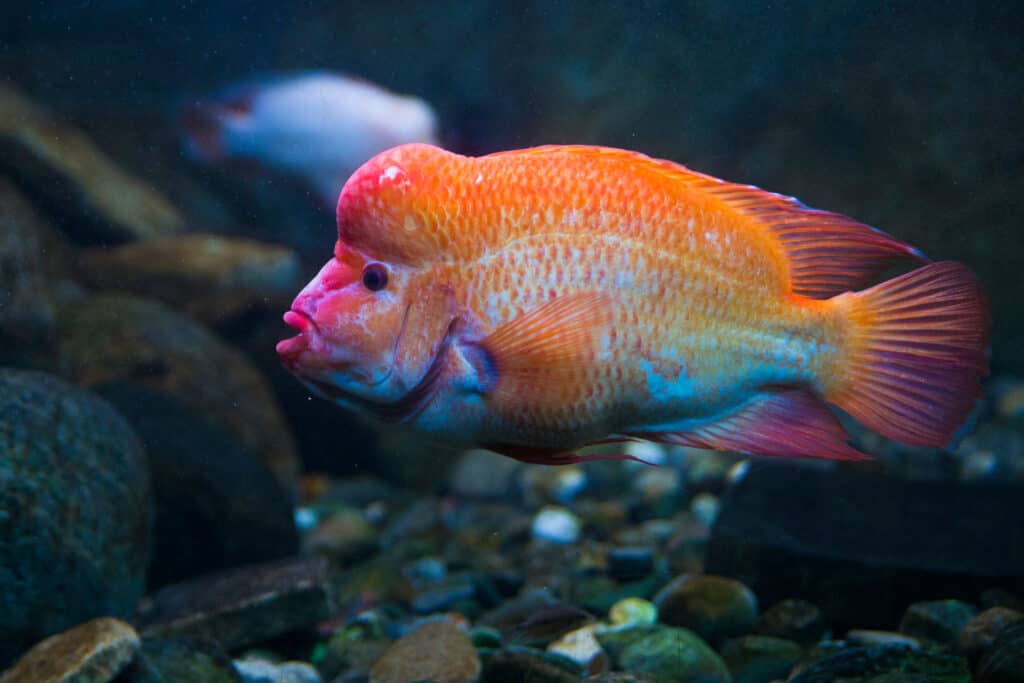
Red Devil Cichlids have a similar life expectancy to their smaller cousins.
©Mircea Costina/Shutterstock.com
Midas Cichlids are one of the longest-lived species of fish in the world. They can live as long as 10-12 years in captivity, and some exceptional individuals have even been known to exceed this number. Red Devil Cichlids have a similar life expectancy to their smaller cousins. Parasites and bacteria, as well as fungal infections from dirty water, may shorten these fishes’ lifespans dramatically, so proper care of their environment is essential.
Midas Cichlid vs Red Devil Cichlid: Pet Care
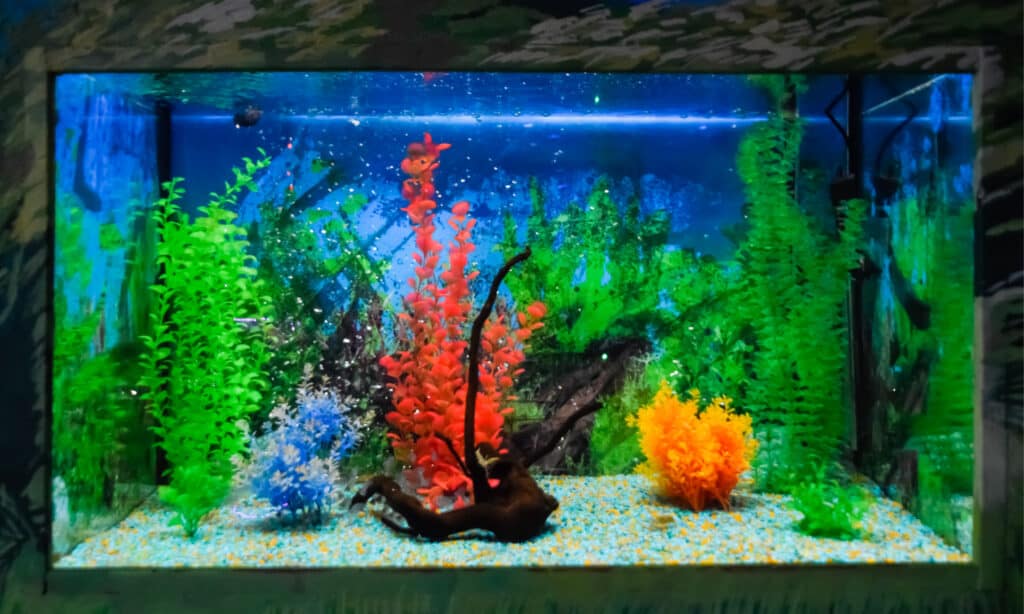
Both Midas and Red Devil Cichlids need plenty of space in their aquarium environments.
©iStock.com/Leonid Eremeychuk
As previously mentioned, a large aquarium of at least 55 gallons (for a single fish) is necessary to keep these species healthy. Both species can be territorial and aggressive when kept in groups, so allowing ample space to stake out their territory is essential.
As omnivores, a diet comprising both plant and animal material is essential to their wellbeing. Earthworms, bloodworms, and nightcrawlers can provide a vital source of protein, while fish flakes and other prepared foods will give your fish a solid nutritional foundation.
Both Midas Cichlids and Red Devil Cichlids may suffer from common fish diseases, including:
- Ich: A parasitic infection causing white spots and weakness
- Hole in the Head Disease: A disease-causing pit to appear on the fish’s head
- Dropsy: A bacterial infection affecting the kidneys
These fish make good pets for experienced fish owners who can provide for their unique needs. Before bringing any fish home, extensive research should be conducted to ensure potential owners understand all aspects of their care.
The photo featured at the top of this post is © Andrej Jakubik/Shutterstock.com
Thank you for reading! Have some feedback for us? Contact the AZ Animals editorial team.






